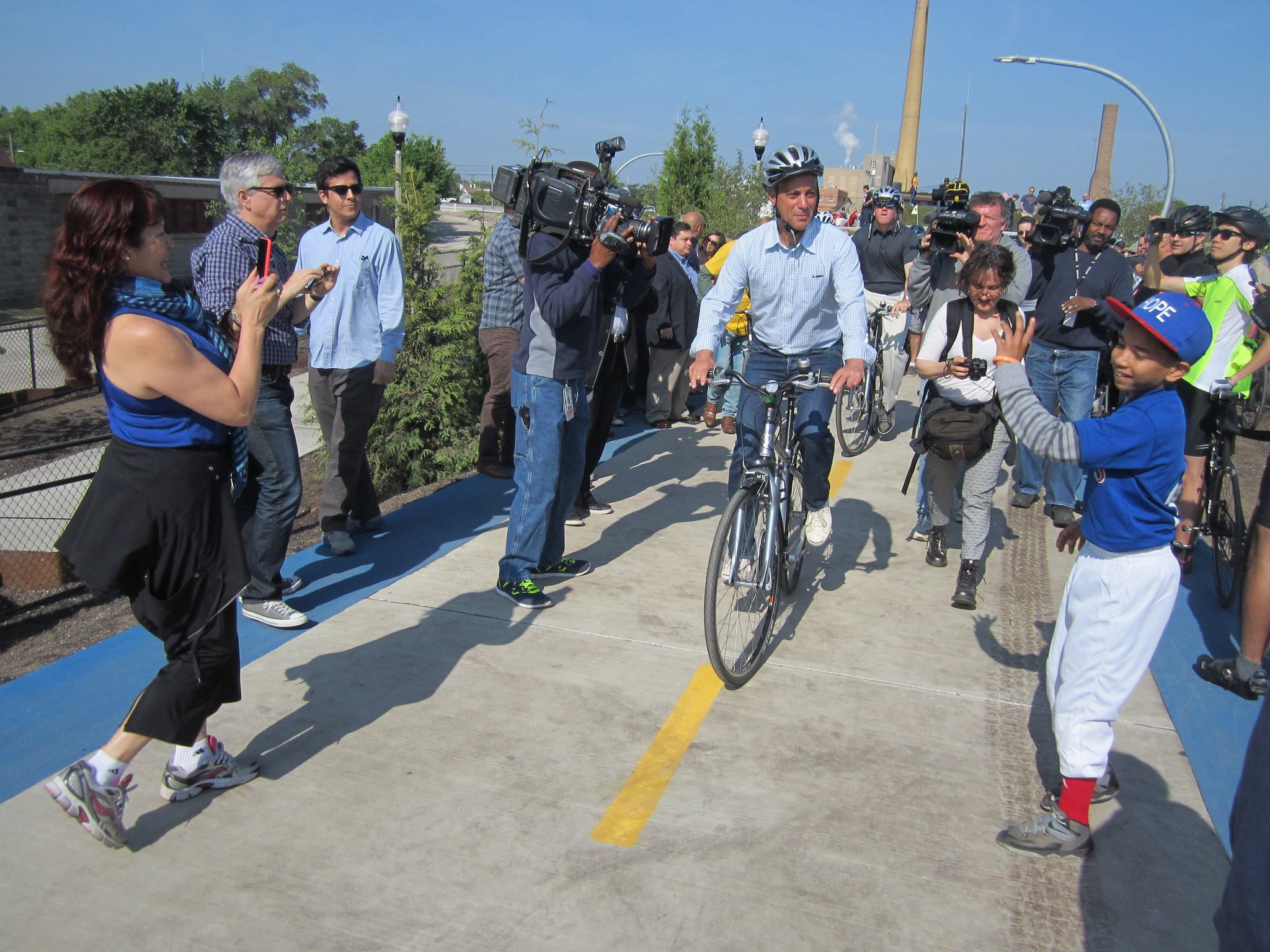With apologies to Shakespeare, I come to bury the Rahm Emanuel administration, not to praise it. In the wake of today’s bombshell announcement that Chicago’s mayor will not run for reelection, I’d like to take a moment to assess Emanuel’s transportation legacy.
First, the many controversial aspects of Emanuel's time in office must be acknowledged. These include allegations that the mayor has failed to adequately address the recent spike in gun violence, and tried to cover up the police shooting of Laquan McDonald. He’s also been slammed for closing half of the city’s mental health clinics and some 50 public schools, mostly in Black and Latino communities, while allegedly promoting the gentrification of communities of color. Critics have also accused him of misusing the city’s tax-increment financing program to provide tax breaks to corporations and developers, at the expense of school funding and other public needs, and raising property taxes to cover revenue shortfalls.
That said, Emanuel has racked up a number of wins for sustainable transportation and traffic safety during his seven-plus years as mayor. Here’s a partial list of completed or in-progress projects:
- Red Line South Reconstruction
- Lined up funding for Red and Purple Modernization on the North Side
- Your New Blue O’Hare branch station and track improvements
- New stations at Morgan, Cermak, Washington-Wabash, Wilson, and 95th
- Loop Link, Union Station Transit Center, Jeffery Jump
- Nation’s first ride-share fee to fund transit
- Passed transit oriented development ordinance
- Introduced a speed camera program
- Built the Chicago Riverwalk extension
- Launched the Divvy bike-share system
- 100-plus miles of new and upgraded bikeways, including protected lanes
- Opened the Bloomingdale Trail
- Pedestrian and bike path separation on the Lakefront Trail
But as transportation analyst Yonah Freemark noted in a Twitter thread earlier today, Emanuel was also guilty of some failures and missed opportunities when it comes to improving Chicago transportation. Freemark argued that the mayor abandoned planning studies like the one to improve Museum Campus transit, and eventually slowed the pace of bike and pedestrian improvements. He also noted that the O’Hare express project, which was awarded to the increasingly erratic tech mogul Elon Musk, has been a major distraction, and that the mayor gave up on making some important improvements to bus service that could have helped reverse the declining bus ridership trend:
But Rahm also did little in the face of quickly declining bus ridership, resisting moves to implement all-door boarding or bus lanes. He even supervised the decision to stop progress on Ashland BRT, which would have been a good project.
— Yonah Freemark (@yfreemark) September 4, 2018
So what should be on the transportation platforms of Chicago’s mayoral hopefuls, whose chances of winning are now much greater due to the absence of an incumbent in the race?
Many transportation advocates, including Freemark, have argued that making bus service faster and more reliable will be key to stopping the CTA’s ridership bleeding and making the system more equitable and financially sound. In addition to more frequent bus service, Chicago needs many more miles of bus lanes. Currently we only have four miles, a fraction of the mileage in peer cities like New York, Los Angeles, and San Francisco. Other time-saving features like prepaid, level, all-door boarding, and transit-friendly traffic signals should be added to bus routes across Chicago.
Other transit needs include finding funding for the $2.3 billion South Red Line extension and/or converting the Metra Electric District line to rapid transit. Advocates have also called for integrating the CTA and Metra fare systems, and Freemark says the city should look into building more grade-separated transit corridors, such as along the riverfront.
Transportation justice activists like Equiticity’s Oboi Reed have called for eliminating the possibility of increased traffic enforcement in communities of color as part of the city’s Vision Zero program to reduce serious and fatal crashes. Reed and others have also demanded that the Chicago Police Department end its admitted practice of writing exponentially more bike tickets in Black and Latino communities as a pretext to conduct searches.

Mayoral candidates should also commit to bringing the traffic safety and public space improvements that have become common in many of Chicago’s more affluent neighborhoods to more parts of the South and West sides. These include improvements walking like curb extensions, refuge islands, raised crosswalks, and new public plazas, plus bike facilities like protected lanes, neighborhood greenways (traffic-calmed side-street routes), and Divvy stations. Since these are often funded with ward menu funds, which may be more difficult to spend in under-resourced neighborhoods, the city should create a dedicated fund for walking and biking infrastructure.
In the wake of the news, Active Transportation Alliance director Ron Burke praised the Emanuel for his sustainable transportation accomplishments. “Under Mayor Emanuel’s leadership, Chicago strengthened its commitment to building safer streets that make it easier to get around without a car.”
But Burke added that on the vast majority of Chicago streets, it’s still too difficult to walk, bike, or take transit. “Safety and connectivity challenges are greatest in low-income neighborhoods and communities of color, where residents with few transportation options lack access to jobs, schools, healthcare centers, and other critical services.”
He promised that Active Trans will urge the mayoral hopefuls to prioritize smart and equitable transportation initiatives with its “Walk and Roll the Vote” campaign to educate the candidates and voters in 2019 election about the city’s most crucial travel needs. This will include a sustainable transportation platform, developed in partnership with other organizations and residents from across the city.





